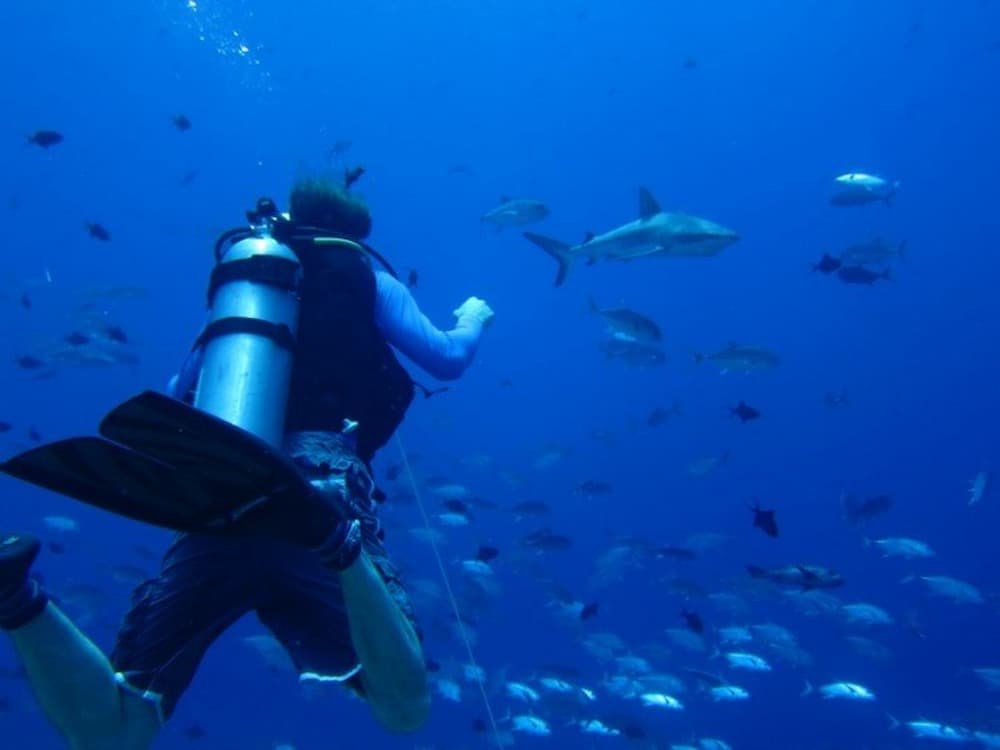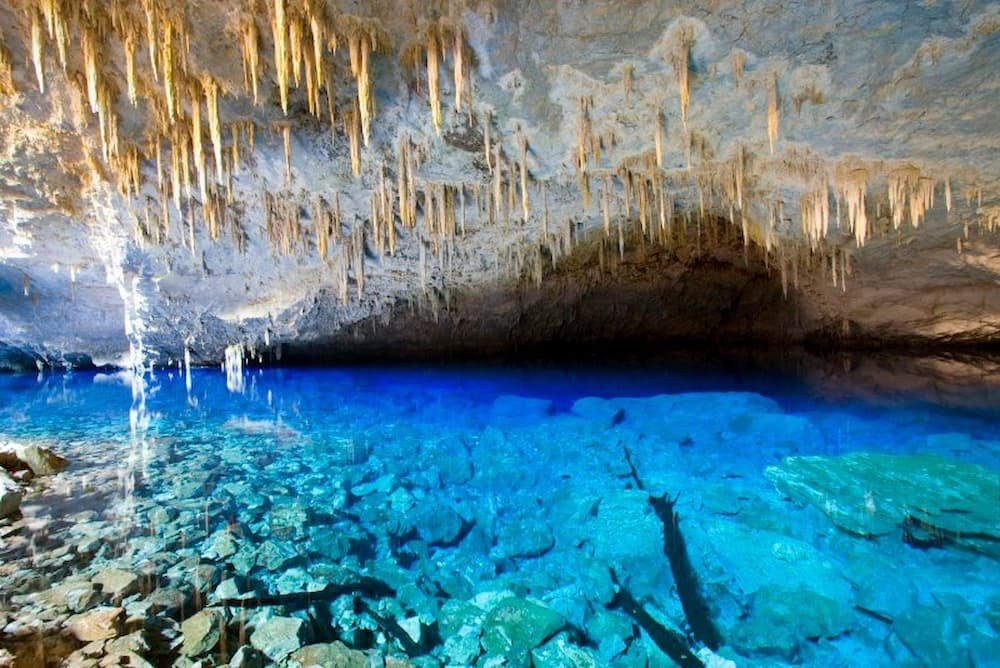While SCUBA diving is considered extreme to some people, if you are looking to step up your game, try your hand at cave diving. This takes the risk level to a whole new level by adding the element of complete darkness, narrow shafts or tunnels that are often difficult to navigate, and minimal options when something goes wrong.
Below, you will discover some of the most epic places around the world for cave and cavern diving. Please DO NOT attempt these dives without the proper training and certification.
As always, if you think we have missed any please let us know in the form at the end of this list.

Ranked by Discovery Channel on their list of “The 10 Most Amazing Places on Earth”, the Great Blue Hole found in Central America is truly unique. A limestone sinkhole formed thousands of years ago, it has a total of 11 underwater caves each with its own depth and length. A top thing to do in Belize, it has also received world recognition from UNESCO. Truly a world-class destination for cave diving.

Just outside of Tulum, Mexico in the Yucatan, divers can find another interesting dive site made of a mixture of salt and fresh water, lots of cave formations, boulders, and stalactites. The catch, they have to make the dive by jumping into the water first and as attested by many can easily get lost in the dark cave passageways. For comprehensive travel information on Tulum and the entire Yucatan Peninsula, Travelyucatan.com is a great resource.

Want to enjoy cave diving with the clearest water you can find? Then head over to Ginnie Springs in Florida. Here you will find four of the most dive-able springs: Ginnie Springs, Little Devil, Devil’s Eye and Devil’s Ear, the most frequently dived caves in the world. A favorite for divers, this area is where you can practice your underwater photography skills to the fullest.

First Cathedral is the most popular dive site off Lanai, Maui. The dive site contains a huge chamber with cut-outs in the lava forming “stain glass windows” with the sun shining through. This dive is not rated as a difficult cave dive and can be completed by divers with a basic Open Water certification.

Ojos which means “Two Eyes” in Spanish, is a flooded cave system located in Yucatan, Mexico. It refers to two neighboring cenotes that connect it into a large cavern. Cave diving here is a guided adventure following lines like the Barbie Line (there’s a plastic alligator with a Barbie doll in its mouth) because it is quite easy to get lost in the tunnels and could prove to be fatal. Continuing on, divers have the option to go to another cenote which is the “Bat Cave”.

Politically considered a single island, it has a greater area than the rest of the Bahamian islands. It’s an archipelago within the Bahamas famous for its many water-filled cave systems known as Blue Holes. Expect to see a diverse range of marine life such as moray eels and lionfish.

An extremely advanced diving site, the Eagle Nest Sink cave system on Chassahowitzka Wildlife Management Area near Weeki Wachee has claimed several lives (six in total) since 1989 earning the name “Lost Sink”. A lot of requirements are needed to be presented like a cave certification card, GUE Cave 2 level experience (minimum requirement), and knowledge with the use of trimix to be able to dive here. Again this is not for any beginner or novice of any level (open water, cavern, cave diving, etc.).

Popular with adults and youngsters alike, Jacob’s Well in Texas is the largest underwater cave in the area although it looks more like a simple swimming hole. Water from the well overflows to a natural spring feeding the Cypress Creek that has slowly been drying up in recent years. Cave divers here can explore 4 main chambers, however, don’t let the well’s appearance fool you, it too has claimed a number of lives.

Earning the ominous title of “World’s Most Dangerous Dive Site” and the even more hair-raising nickname of “Diver’s Cemetery”, the Blue Hole in Egypt can certainly be any diver’s last dive. It is an extremely deceptive dive with dim lighting making nitrogen narcosis more frequent here than in any other diving spot. Maximum care and diving within your own capabilities and limitations is the key to surviving this dive site.

Known as Australia’s best ocean cave dive, it is located just off Smoky Cape at South West Rocks in New South Wales. The cave is 125m long and its name was a tribute to the diverse marine life found here including the gentle, endangered grey nurse sharks. This dive site is open to all levels of diving.

Smack-dab in the middle of an Australian farm (Kilsby Farm), divers marvel at the astounding features they see when diving in this limestone cavern. One of the first sinkholes to be visited by numerous divers since the 1960s. With a tragic double-drowning in 1969, the site was closed to be later leased for research testing. With an access agreement in place, the site has been reopened for conscientious divers.

The most popular diving site in Palau, Blue Corner wall extends to Blue Holes where divers can explore many caverns and caves meant for experienced cave divers. This place has currents that can present a problem for beginners. Marine life like sharks are common here.

The infamous sinkhole discovered in Mount Gambier is named appropriately. The entrance and exit are via a small hole opening in the ground. Each diver must be lowered, along with their equipment. Timing is of the essence when diving here and a sharp eye to your air tanks will help in ensuring you make it back to the top.

A popular site for both cave diving and snorkeling, it has three main features particularly fascinating to cave divers. ‘First Pond’ is an open depression, the ‘Chasm’ which is a sinkhole, and the ‘Cathedral’ with limestone formations. All three have varying depths with excellent visibility. Take note though that diving here is by permit only.

The only oceanic island in Malaysia, it is listed as one of ‘The Top Dive Destination in the World’. While Pulau Sipadan is home to a diverse marine life including barracuda, big-eye trevally, and bump head parrotfish, the Turtle Tomb is the most famous. This limestone cave of labyrinthine tunnels is where you can find the skeletal remains of turtles (green and hawksbill).

This protected national park consists of nine islands thus the name Similan which is a Yawi (the language of Thai Malays) word meaning ‘nine’. The best dive site is the Elephant Head Rock, so named because its granite boulders resemble an elephant. It has a maze of swim-troughs and spin-cycle currents so care is needed when making a dive.

Located in Indonesia’s West Papua province, Raja Ampat Islands (or Four Kings) is another diver’s dream paradise with interesting mythology. It is ranked at the top of underwater biodiversity for its highest record of marine life diversity. Visitors here are encouraged to dive in Farondi, east of Misool Island, for its one-of-a-kind underwater landscapes.

Diving in the archipelago’s many undisturbed islands is relatively new. One such island open for diving is the Western Rocky Island, a small limestone island, located on the island’s eastern tip. Here divers are treated to a large tunnel running through the island where crabs, shrimp, snappers, sharks, stingrays, and corals are abundant.
This is an advanced cavern dive so make sure not to disturb the bottom so as not to reduce visibility. Other dive sites are the Fan Forest Pinnacle, High Rock, North Twin Island, North Twin Plateau, Three Islets (In Through the Out Door, Black Rock, Burma Banks), Northeast Little Torres Island, and Shark Cave.

The Maldives is one of the premier diving destinations in the world. In Broken Rock, there is a channel where divers can swim through. Use caution when diving here as the currents can be strong. When currents are slow, even beginners can dive here but are advised not to when the currents become stronger.

Orda Cave is a gypsum crystal cave found underneath the western Ural Mountains. The mouth is near the shore of the Kungur River just outside Orda, Perm Krai in Russia. The cave system stretches over 5.1km with the majority being underwater. This makes it one of the longest underwater caves and the largest underwater gypsum cave in the world.

Belonging to the Tavolara Islands, Secca del Papa (Pope’s Shoal), should be included in any diver’s itinerary when visiting Italy. It is said to be the most famous dive in the Protected Sea Area of Tavolara. This site offers spectacular underwater scenes of red gorgonian and marine life, most notably groupers and barracudas.

Rated among Europe’s top dives and located just below “Azure Window”, both are situated on the small island of Gozo in the Mediterranean Sea. This site is perfect for all levels, beginners and seasoned divers with its many depths and routes each can explore two underwater caves with eye-catching light. Furthermore, divers can either go on and swim towards the sea or go back to the caves at the back of the hole.

The Silfra fissure is one of the top dive sites in the world. It is the only place where one can dive or snorkel directly in the crack between two continental plates, of the North American and Eurasian continents. The visibility in the Silfra fissure is over 100 meters, due to the frigid glacial waters.
Read about our experience snorkeling the Silfra Fissure.

Emergence du Russel is a large impressive cave that starts in the bed of the River Céle. It splits into two passages: one tunnel stays shallow at around 10m deep whilst the other drops repeatedly until it reaches around 18m. The two passages rejoin then the cave takes the first of two dramatic plunges, eventually descending in a spectacular cavernous rift to about 45m. The whole trip through is a serious expedition of several hours and has been made by only a handful of people ever.

Rappel 72m down into a cave and an underground, crystal clear lake, 80m deep, with an area equivalent to the size of a football field. Snorkeling or diving reveals the breathtaking beauty of this place: some of the largest underwater stalagmites in the world, up to 18m high.

When people say Antarctica, the first things that come to mind are penguins, ice, snow, and freezing water. Most didn’t know that there’s an excellent diving spot right under those tons of ice if they can withstand the freezing temperatures. Underwater is a whole different world of sponges, corals, and starfish with emperor penguins and seals swimming in search of food. Needless to say, diving here will require a different set of skills and techniques. A portable hut is placed over the hole made by divers to help them.
